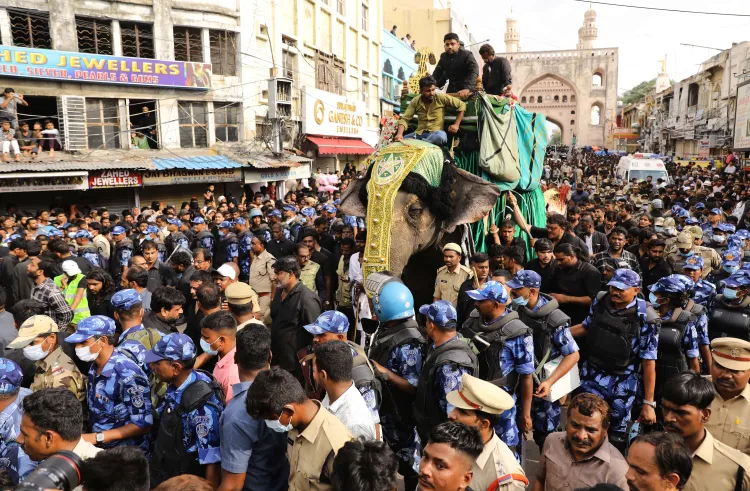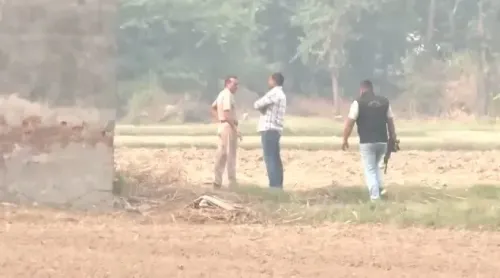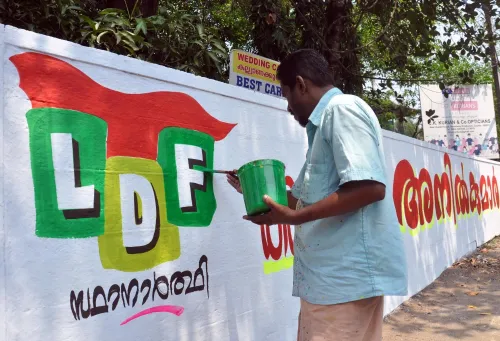How Did ‘Bibi-Ka-Alam’ Procession Unfold Peacefully in Hyderabad?

Synopsis
Key Takeaways
- Bibi-Ka-Alam procession is a significant cultural event in Hyderabad.
- It commemorates the martyrdom of Imam Hussain.
- Extensive security measures ensured a peaceful observance.
- Tradition of carrying the alam on an elephant has been ongoing for centuries.
- Community participation highlights the importance of historical remembrance.
Hyderabad, July 6 (NationPress) The historic ‘Bibi-ka-Alam’ procession unfolded peacefully in the historic neighborhoods of Hyderabad, amidst stringent security measures, as the day of 'Yaum-e-Ashura' was observed with deep reverence and mourning on Sunday.
Numerous participants joined the procession, commencing from Bibi Ka Alawa in a traditional manner and culminating at Chaderghat along the banks of the Musi River, traversing through various sections of the old city.
The procession made its way through key locations such as Sheikh Faiz Kaman, Yakutpura Darwaza, Etebar Chowk, Charminar, Gulzar Houz, Panjeshah, Mani Mir Alam, Purani Haveli, and Darulshifa.
The 'Bibi ka Alam' was elegantly carried on a richly adorned elephant, which was transported from Karnataka.
The organizers arranged for the elephant from the Sri Karibasaveshwara Mutt in Karnataka after the Telangana Forest Department denied permission for an elephant previously identified in Delhi, citing animal welfare and transport regulations.
‘Yaum-e-Ashura’, the 10th day of Muharram, is commemorated in honor of the martyrdom of Imam Hussain, the grandson of Prophet Mohammed, along with his followers during the battle of Karbala.
The alam, adorned with gold and diamonds, is believed to house a piece of the wooden plank used for the final ablution of Bibi Fatima Zehra, daughter of Prophet Mohammed.
This alam has been in place for over 430 years, established during the Qutub Shahi dynasty, and the tradition of carrying it on an elephant has persisted since that time.
In past years, elephants from Nehru Zoological Park were utilized for the annual procession. However, following court restrictions on the use of captive elephants for religious events, organizers have been sourcing elephants from other states.
Last year, an elephant from the Shri Jagadguru Panchacharya Mandir Trust in Karnataka was brought for the event.
Groups of self-flagellating mourners led the procession, with blood visibly flowing from the heads and chests of bare-chested Shia mourners who engaged in self-flagellation with sharp objects.
Amid shouts of 'Ya Hussain' and the recitation of 'marsiya' (elegies) and 'noha-khwani' (sorrowful poems), barefoot youths inflicted injuries on themselves using knives and blade-encrusted chains, demonstrating solidarity with the martyrs' suffering. Others were seen weeping and beating their chests.
The police implemented extensive security measures, deploying over 3,000 officers. Policemen on horseback guided the procession, while traffic was redirected in several areas for the annual event.
High-ranking government officials, including Hyderabad Police Commissioner C.V. Anand, political leaders, and the family of the former Nizam of Hyderabad, paid their respects by offering 'dhattis' along the procession route.
The Police Commissioner oversaw security arrangements from the historic Charminar, issuing timely directives to ensure the procession proceeded without incident.
On behalf of the Hyderabad City Police, Anand presented 'Dhattis' to the 'alam' at Charminar.
With over 3,000 police officers maintaining robust security, the Bibi Ka Alam procession concluded peacefully, without any unforeseen incidents, as stated by the police chief.
Sunni Muslims commemorated the day through fasting and gatherings to honor the sacrifices made by Imam Hussain and his companions, who were martyred in 61 Hijri or 681 CE at Karbala in present-day Iraq.
The fasting is observed over two days – the 9th and 10th, or the 10th and 11th Muharram.









